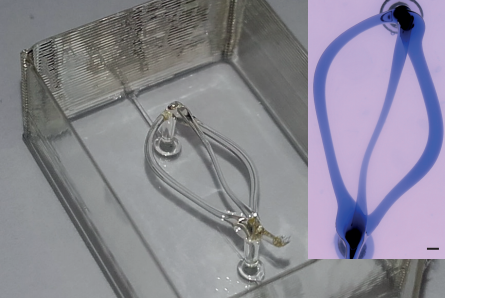Eindhoven University of Technology: Researchers 3D Print Microvascular Structures with Carbohydrate Glass
 As we go about our busy lives each day, it is easy to forget what a miracle the human body is—and when you are feeling tip-top, you can thank the well-oiled machine in the form of the human body that keeps you breathing, talking, and walking. While you are probably familiar with the vascular system (in relation to your circulatory system), you may not also realize that the microvascular system is a vital player in your body, formed of tiny vessels that are, not surprisingly, responsible for microcirculation.
As we go about our busy lives each day, it is easy to forget what a miracle the human body is—and when you are feeling tip-top, you can thank the well-oiled machine in the form of the human body that keeps you breathing, talking, and walking. While you are probably familiar with the vascular system (in relation to your circulatory system), you may not also realize that the microvascular system is a vital player in your body, formed of tiny vessels that are, not surprisingly, responsible for microcirculation.
The microvasculature is made up of arterioles, capillaries, metarterioles, and more—and the vascular system overall has been connected with 3D printing numerous times over the past few years from bioprinted vascular scaffolds to 3D printed models for microvascular surgery to viable 3D printed tissue.
Today, researchers are still challenged to find ways to imitate and re-create the microvasculatur system with fabrication in 3D printing trending toward using devices such as an “organ-on-chip.” A team of scientists at Eindhoven University of Technology has been exploring this route further, as they explain in ‘3D printing of round microfluidic channels to mimic the microvasculature,’ presented last year in Montreaux at the Nano Bio Tech Poster Sessions.
Obviously, many parts of the human body are complex and hard to mimic; for example, consider that we still are not able to 3D print human organs. We may be getting closer, but it will be the holy grail of bioprinting when it happens. Just trying to make something like microvascular ‘components’ is a substantial undertaking, and the researchers explain this because of the difficulty in translating the cross sections, smaller diameters, and network architectures that are intricate.

Free-standing structure of carbohydrate glass inside a printed casting frame mimicking the vascular architecture. Insert: Perfused network with dye solution after dissolving carbohydrate glass cast in PDMS. Scale bar 500 µm.
3D printing with carbohydrate glass is one viable option that has been suggested by researchers, but the Eindhoven scientists want to use multiple types of materials in fabrication, along with making the parts smaller:
“Our main focus was to reduce the diameter to a size closer to the microvasculature, namely in the 10-500 μm range and be able to engineer hierarchical 3-dimensional branching networks that can change diameter along the vessel.”
The team set up a 3D printer with a heated barrel connected to a Nordson EFD performus III pressure control system. Standard nozzles were applied with a .4 mm diameter, and the researchers were able to adapt the diameter limits through limiting or speeding up the movement. In using self-supporting carbohydrate glass as the material of choice, there is greater latitude in printing complex geometries. As in so many 3D printing research projects, temperature is a significant consideration—and is often an obstacle when it cannot be manipulated properly, resulting in deformation of parts.

Carbohydrate fibers strung from droplets horizontally across a
printed frame with a speed of 600 mm/min. Insert: Microscopic image of 3 fibers, top and bottom strung left to right and middle right to left at 600 mm/min. Fibre diameter ~100 µm
The researchers state that a great portion of their work in 3D printing microvasculature will be centered around controlling the thermal elements in fabrication.
“This will offer even greater freedom in network design, and it will give the possibility to exactly control reflow of fibers to form a single in-plane junction,” conclude the researchers. “In the end, the printed models will be used to investigate the flow of blood and particles inside the blood through a microvascular network, leading to a better understanding of perfusion and particle distribution/interaction in the microvasculature.
What do you think of this news? Let us know your thoughts! Join the discussion of this and other 3D printing topics at 3DPrintBoard.com.

Boxplot of diameter for different movement speeds of the stage. Increasing speed reduces variance and average diameter of the fiber insert: The high variance of the diameter at 300 mm/min can be explained by the strong tapered shape of the fibers, resulting in a different diameter at the start and end of the fiber. This is probably caused by solidification of the droplet at the nozzle tip leaving less material to string from.
Subscribe to Our Email Newsletter
Stay up-to-date on all the latest news from the 3D printing industry and receive information and offers from third party vendors.
Print Services
You May Also Like
3D Printing Financials: Prodways Ends 2024 with a Profit
After a tough couple of years, Prodways (EPA: PWG) is starting to bounce back. The French 3D printing company finally made a profit in 2024, improved its operating performance, and...
Blue Origin & Auburn University Use EOS M290 to Study Copper 3D Printing
Blue Origin, the commercial space company built off of investments from Amazon founder Jeff Bezos, has donated two EOS M290 powder bed fusion (PBF) printers to Auburn University’s National Center...
Rocket Lab to Acquire Restructured Laser Communications Provider Mynaric AG
Rocket Lab USA, the Long Beach-based, end-to-end space services company that specializes in producing rockets with additive manufacturing (AM), has announced plans to acquire Mynaric AG, a German provider laser...
3D Printing Financials: Stratasys Ends 2024 with Cost Cuts and Growth Plans
Stratasys (Nasdaq: SSYS) has wrapped up 2024 with stronger margins but a full-year net loss. The polymer 3D printing leader navigated a year of economic headwinds, restructuring efforts, and shifting...



























